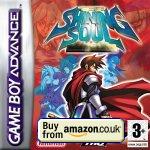Shining Soul on GBA didn’t do too well. The most hardcore Shining fans disliked its real-time gameplay when compared to its turns-based roots, and the general games-buying public tended to stay away from it too. However, my experience with Shining Soul II has been nothing but positive.
Streamlined controls
 As a fast-paced action RPG on a handheld, the control system has to be absolutely clear, yet versatile enough to support different situations, and SSII gets it just right.
As a fast-paced action RPG on a handheld, the control system has to be absolutely clear, yet versatile enough to support different situations, and SSII gets it just right.
Fast food menus
The L menu holds weapons; the R menu items. Tapping the shoulder button opens the menu and scrolls through, and B uses the item (weapons are equipped automatically). In multiplayer, holding B throws the selected item, letting you heal your teammates.
Pressing A unleashes a standard attack, and holding it charges up a more powerful attack. With higher levels and better weapons come stronger attacks, but they take longer to charge. It’s actually very well-balanced.
Huge selection of items
I was expecting there to be a shortage of useful weapons, items and armour with this being a handheld RPG, but the range is absolutely vast.
- Multiple weapons. The brawler has the claw and knife – and these increase in grade as you go through the game. Some have effects such as defence up, HP recovery or attack properties.
- Armour boosts. Wearing all the armour pieces of a particular set gives you an extra boost in certain statistics. This makes it even more desirable to collect the highest-level armour possible, as adding the final piece of the puzzle can put your stats up enormously!
- Item oddities. Antidotes and healing herbs are present, but most interesting are the stranger items: old Sega consoles, speech bubbles, cats and more. Some of these come in sets that lead to even rarer items.
Gratifying gameplay
I’ve left this for last even though I suppose it should be more important. The best thing about Shining Soul II is that it’s fun to play. For some reason I want to describe it as “scrappy”, not because it’s put together badly but because most of the combat takes place at close range (apart for rangers, who are boring and overpowered, as is traditional!) – I’ve shouted “run away, run away!” to my character many times!
When you level up you get free choice of where to add your four stat points, giving you a great sense of being able to develop however you like instead of boosting or adjusting statistics to compensate for the pre-determined level-up.
You also get another kind of point which you use to level up your character’s skills. These could be the ability to equip stronger weapons, increase their healing power or gain attack power when in danger. Each character has different abilities, so they’re all truly different.
Sometimes the bash-bash-flee gameplay gets a bit tiring, but a great item or weapon always seems to come along at just the right time. Even if it doesn’t, with eight very different character classes you can always explore another aspect – I loved my brawler Groudon until I got a ranger, and loved him until I got a magician and a swordsman!
(P)SO similar
I’m a big fan of Phantasy Star Online (with two level 100+ characters – eek!) and SSII shares some of its best and worst bits.
- Got soul! You can equip items that unleash devastating attacks if you take a lot of damage, rather like Photon Blasts.
- Hit, run, hit. The whole “run in, hit them, run away” style of play was perfected by PSO, but with SP recovery as standard in SSII it makes even more sense.
- Stupidly rare items. I know I’m never, ever going to get a Psycho Wand, and I also know I’m probably never going to get a full set of SEGA letters to make a beautiful Sega speech bubble.
- Co-operative focus. Sometimes I like to compete, but I’d rather work together to solve puzzles and progress through the game, using everyone’s skills together.
In short
Shining Soul II is a simple game with plenty of depth to explore. Sidequests, unique items and other titbits are plentiful, and with the multiple character types you never feel resigned to grinding out levels, as in many similar RPGs for the PC.
I often think that the measure of a good game is whether writing or thinking about it makes you want to play it. I get reminded of their charms and some of the good times I had with them, and I know that if I picked them up again I’d discover so much more. Shining Soul II passes this test with flying colours.
However, there is one thing Shining Soul is missing. Something important and potentially amazing that a Shining Soul III on DS could rectify.
Something I’ll write about on Friday!

 My name is James Newton, and this is my website - a collection of my writings about
videogames, music and all my other thoughts.
My name is James Newton, and this is my website - a collection of my writings about
videogames, music and all my other thoughts.